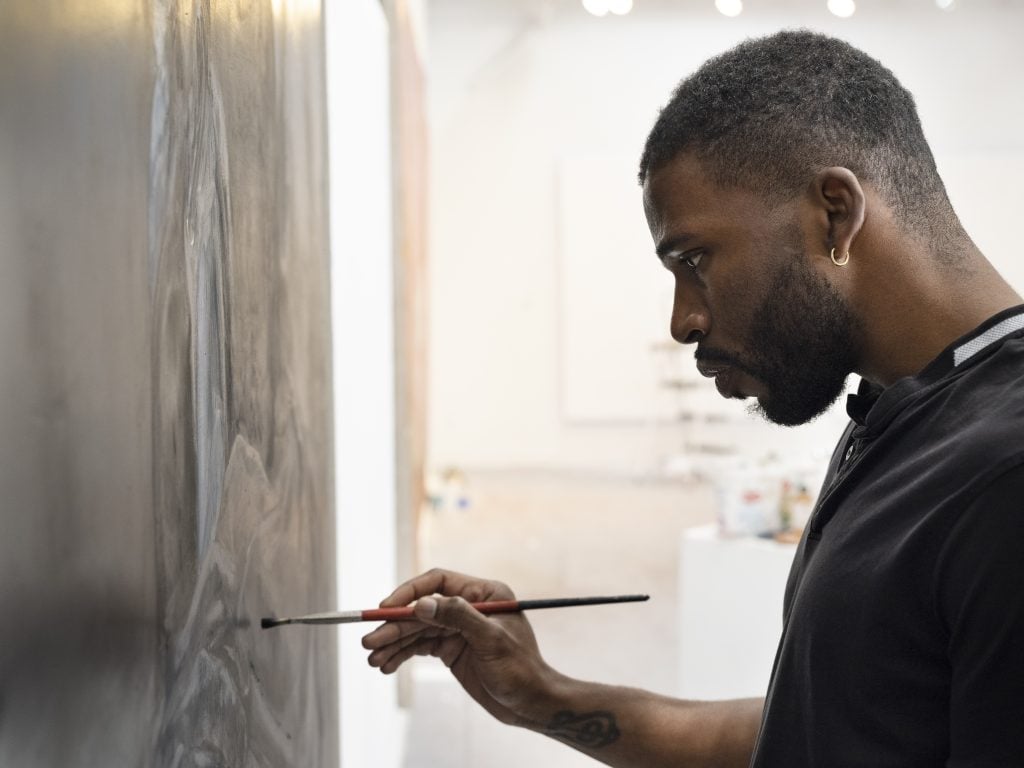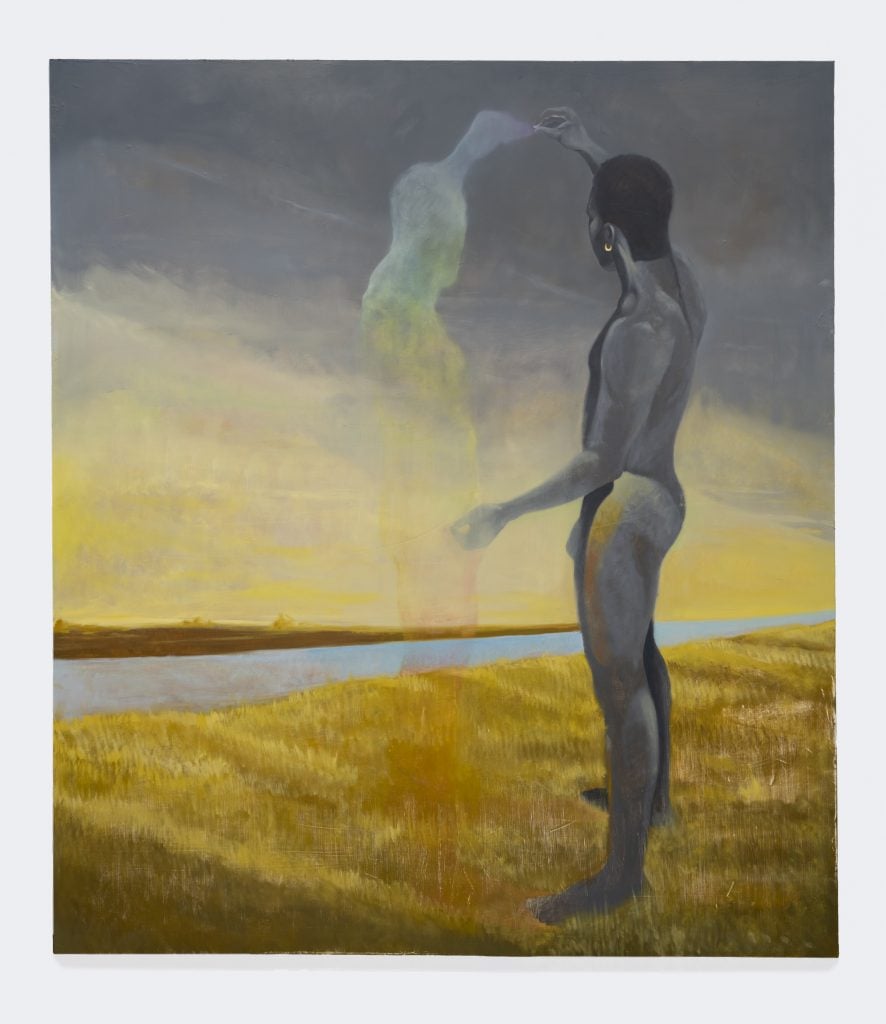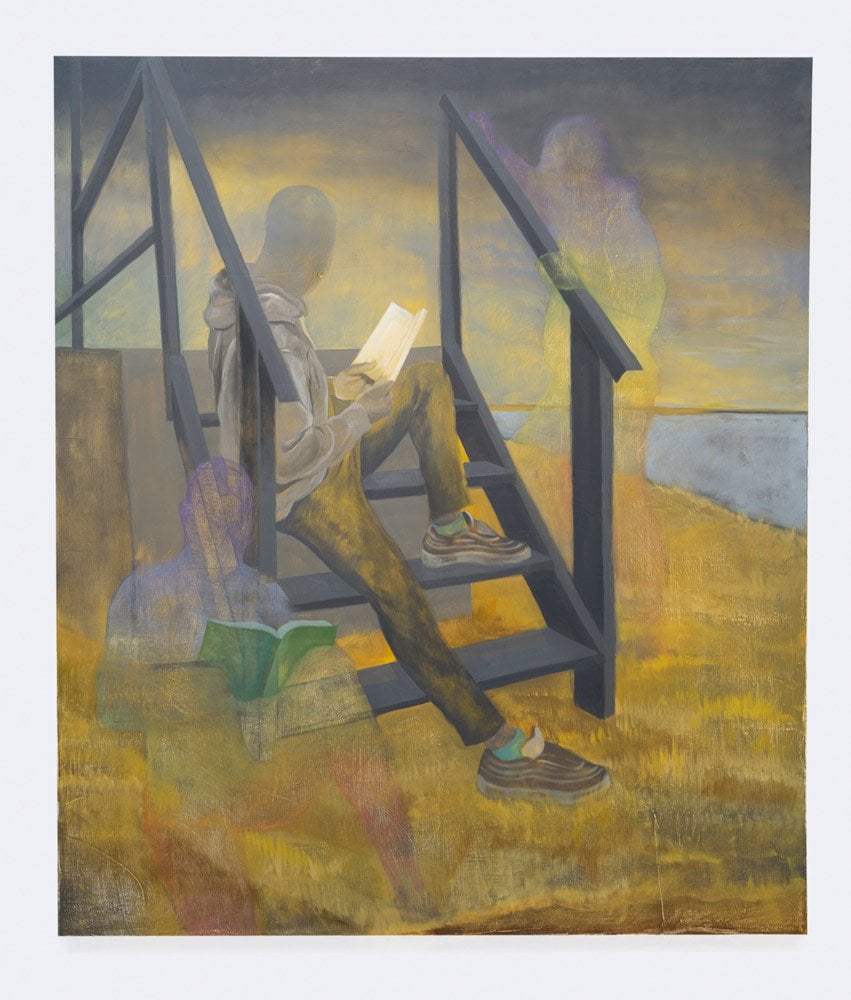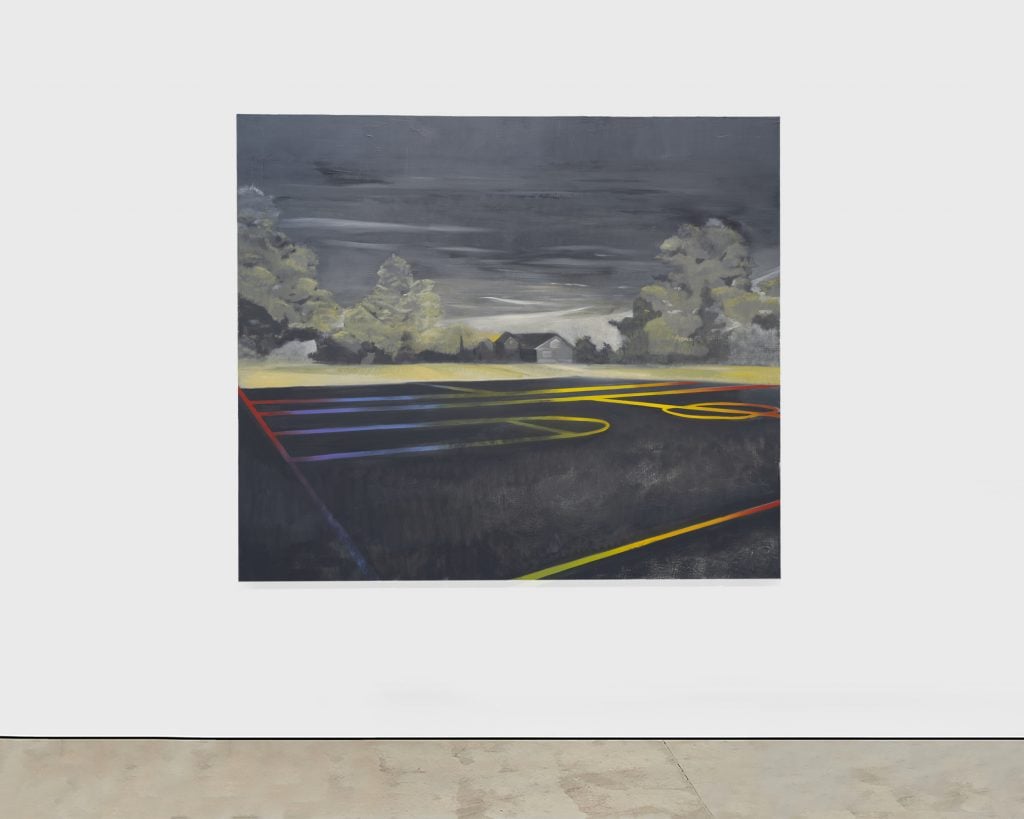People
Painter Dominic Chambers on How Jungian Theory Shaped His Art, and the Transformational Role of Therapy in His Own Life
"You have to go back and uncover what has happened to you," the artist said.

"You have to go back and uncover what has happened to you," the artist said.

Jasmine Wahi

Just a year after Dominic Chambers graduated from the Yale MFA program, the world went into the lockdown of 2020 and he, like so many of us, turned inward. In a new exhibition of the artist’s paintings at Lehmann Maupin (through March 5), we witness Chambers’s reflections on his early life and his personal transformations over time in a series of paintings done during the pandemic era.
We spoke with the artist about the influence of Carl Jung’s Shadow Work on the show, which is titled “Soft Shadows,” his literary influences, and his future plans.
Some folks who read this might be familiar with your work, but can we start with a very quick elevator pitch overview of the show?
The show is essentially my attempt to take the therapeutic practice of “shadow working” and disseminate that approach through images related to my shadow, in a surrealist sense and in a more personal sense. Some of these things are internal issues, and whenever I’m dealing with internal issues it becomes easier to think about them in the context of their absurdity. And surrealism and macrorealism, for me, is the easiest way to do that.
For those of us who aren’t familiar, what is shadow work?
Shadow working is a therapy founded by Carl Jung, the analytical psychiatrist. Shadow working is essentially when you do some introspective work to uncover parts of your identity or your personality you have potentially neglected or not addressed, but effect your personality and your life. So you have to go back and uncover what has happened to you, relationships with people and environments, and to recontextualize those things and to revise them in a way that’s suitable for your life today.

Dominic Chambers, Self-Summoning (shadow work) 2022. Photo courtesy of Lehmann Maupin, New York.
I’m thinking very technically about what a shadow is: something that projects or refracts off of you. In this idea of shadow work, do you consider the figures in the works to be projections of self or simply other elements of the complexity that is you?
There are elements that are the complexity of you. The shadow self is the personality you may not want to acknowledge. It’s like the cheating spouse [laughs]. When you’ve done something you don’t want to admit to, you project onto something else, right? In a sense that’s your shadow self operating and coloring your interpretation of the world. For me, when I think about the shadows in my paintings, it’s a recontextualization of that shadow self because I don’t want to think about my shadow as a problematic or tumultuous thing. That’s why they’re all rainbows, because light goes through it. Your shadow doesn’t have to be a dark thing, right? These things are just a part of you.
Do you think the shadow self could be akin to a ghost self? A specter? Or is it more solid than that?
I would say a ghost self, for sure. There’s a painting in the show that’s like a self-summoning, in which you summon past versions of yourself to make sense of where you are now. Because you’ve had values, judgments, and world views that may have been necessary for you at one point in time, but may not be relevant for you today, and then eventually that becomes your ghost self. So summoning my ghosts or my shadow selves, the younger versions of myself, was necessary for me to understand the kind of man I want to be, the kind of artist I want to be, the kind of values I want to hold. My relationship to the kind of images I want to produce that are truly mine, and in that sense, they are dependent on essentially this validation of the world.
Tell me about validation from the world.
I would say with any artist, or frankly just any person living in this country, one’s validation is often held in the power of other people. Often white people, for example, and the institutions. So anything you produce is often measured by their sense of validity, and that robs you of your power. It really does. That reclaiming of power, that reclaiming of wholeness, is also a part of the shadow working. Then you don’t need that validation. Your images stand on your own.
So it’s a self-validation you’re referring to, not being the object of someone else’s validation.
Exactly. You have to have that self-validation. There are those who have a sense of self-worth instilled in them, but as that person encounters the world, they understand the system they’re occupying, and that you often have to acquiesce to the system. You have to perform to live, you have to weave a personality to exist. And that is a problem for me.

Dominic Chambers, Untitled (Ife In Red) (2021). Courtesy the artist and Lehmann Maupin, New York, Hong Kong, Seoul, and London
Is there a way that you’re able to have both, without fully acquiescing to the white space? Obviously, this exhibition is in a blue-chip gallery where the majority of collectors are going to be white.
I certainly think so. If you do shadow work correctly and if you love yourself correctly, it should give you both, right? Because your self-worth and your life, your talent, your practice isn’t dependent on external validation entirely.
Look at last year: so many people quit their jobs. That’s probably the only good thing about this pandemic; it really forced people, whether they like it or not, to do that shadow work. They’re not naming it that, but that’s what that is. That’s why people are really recontextualizing, reconsidering what it is they’re doing. Like, “Did I condemn my life to this job for this person that doesn’t care about me? Maybe I should pursue myself more?” To reconsider you have to slow down, which this world doesn’t always allow you to do.
Speaking of stillness, it’s something that’s omnipresent in all the works here, a meditative and melancholic solitude. Can you talk about the three works that incorporate yourself as a main figure? And then also discuss the work that doesn’t have any figuration in it.
There’s a large black painting (Shadow Work Chapters) in the exhibition that has defined my self-portrait, me scouring through books. And that painting, the blackness of that painting, is meant to harken back to an earlier piece I made, which is called shadow work on letting go. None of my subjects since then have any acknowledgment [of the viewer]. All of the subjects in the paintings are turning away from the viewer. They’re not interested in acknowledging you or engaging with you. They’re doing that internal work. Shadow Work Chapters is influenced by this idea. I love James Baldwin, and in his documentary The Price of the Ticket, he says: “You think your pain and your heartbreak is unprecedented in the history of the world, and then you read.” That’s everything to me. Because he’s right. He truly understands the lives and universal emotions people have endured. It’s all recorded in books.
Say more about the convergence of blackness and literature in this particular painting [Shadow Work Chapters]?
In a formal sense, there’s an art historical component to it from Baroque painting, the blackness of it all, the use of tenebrism, which is the play of extreme darks and lights. But also, in a spiritual context, the figure is most legible where it’s reading, where it’s engaging with the literal text and finding perspective. The further away you get from the painting, the figure disappears into the blackness. And then you understand that the shadow is a rainbow that’s holding the figure together. And so you realize, through engaging with that image, that the figure is becoming whole.
Through certain writers who are canonical, like Baldwin, a sense of community grows out of the writing. Before you read them, you think these emotional realities are micro-problems or a micro-considerations that exist only for you as an individual.
I think Baldwin’s a great example of how shadow work is done correctly. Like his entire relationship was a renegotiation of his community, his relationship with his father. He had to do a self-imposed exile from America; going to France and then returning with a different perspective.

Dominic Chambers_Self Summoning (shadow work)
You mentioned, and it’s apparent, that all of the figures are turned away. Are there any layered interpretations in the gesture of turning away? And the reason I’m asking that is that there are a variety of ways that you could think about someone putting their back toward you.
It’s important before I talk about turning away to explain why the show’s called “Soft Shadows.” And it’s because of how light works. Everything in here is closely defined because of its proximity to light. The closer a light source is to you, in any context, you understand what something is. The further away a light source gets, what happens to the shadow?
Parameters equal reduction.
Yes, It’s reductive. I wanted to turn away and just reconsider what the fuck I was doing. Creating myself. I think it’s necessary for Black people to define ourselves. I think it’s hard for anyone to be able to define themselves under the pressure of hot light. And that light could be anything. I’m not just talking about whiteness. It could be relationships, your job, your family.
A very passe question: What’s your favorite painting, if you have one?
Fairground Park, for sure. And the Self-Summiting painting. Those were the two last paintings I made. And they almost finished at the exact same time. I was stressing the fuck out, really trying to get them done, and they’re surprising because those paintings really came from a terrible place. I was talking to my therapist and I was on some arrogant shit like, “If my younger self could see me now, right?” And it’s funny because we all adopt that as we get older, that we’re wiser, we’re stronger, we tell ourselves certain narratives that give us a sense of fortitude for who we are, what we’ve endured. But is there something to be proud of really? And I was like, “I don’t know.” Because I have certainly gone away from certain values I had.
Damn, that’s a mind fuck. Your therapist is rude.
Yeah. I was like, damn, because it’s true. One thing he would always talk about was, “How do you sense your boundaries in something?” One of the things that forced me to go into therapy was I found myself leaving certain values, and they didn’t have a place for me. I wanted to be different. My surrealist brain starts thinking, “I love living in the imaginative world.” That helps me give a name to something or an image to my knowledge. Because I understand that language and rationale often fail to describe the things we’re negotiating.
Language is extremely limited.
It’s extremely limited. And so I was like, “Well, I can’t talk to my inner self.” But in paintings, I could. You can summon past versions of yourself. And I’m someone who’s greatly obsessed with upward mobility. Lord knows where that came from, right? So, if you look at Self-Summoning you’ll notice that one foot is on the ground and the other is two stairs up. There’s meant to be this halting; I’m going to run up to him, and before I get too far up there, let me pause. I’ve always been the type to ask myself, So when you look at that painting, you look at a figure that’s a silhouette of a younger version of myself observing, reaching out to myself sitting on the staircase reading. If you look at the naturalized figure, the book I’m holding has no text in it, it’s a blank slate.
I was going to ask.
Just like my nude portrait. Nothing is painted in there except for my earring. Everything else—my head, my thinking, my imagination—is all blank. There’s no details necessary there.

Dominic Chambers, Fairground Park (the shadowy place), (2022). Courtesy the artist and Lehmann Maupin, New York, Hong Kong, Seoul, and London.
This is just a silly question, do you ever reread books from childhood? Do they inform the work?
No, they don’t inform the work, but they make me happy. One of my favorite books is Unaccustomed to Earth, a collection of short stories. I remember the first time I read it, the season, who gave it to me. I want to reconnect with that sensation. It doesn’t inform the work, so to speak, because I’m still dealing with my concerns in the present, but the sensation is important. I like that a book can be a form of time-traveling, in a very direct sense. Because like artworks, books are slow tools for change. They seep into the culture. That’s what authors do, they’re quieter, but it’s effective.
It’s not from my childhood, but by I reread a young adult book called Harun and the Sea of Stories by Salman Rushdie. It’s an amazing book. They talk about the shadow self.
I think we’re in a particular moment of collecting, and a particular moment of galleries paying attention to people like us, and specifically Black figurative painters. And I wonder if you ever question who is collecting the work, or who it’s for?
My work is for kids. Black kids. One of my proudest moments, is when this curator brought their kid to be in front of my painting, and this kid is like, “Me!” He pointed at it, and I was like, “That’s the point. That’s what that kid needs to see.”
My priority will always be those kids. That is my ideal, that is why I might potentially be working in my later years. I’m trying to work with kids through community college. I, too, went to community college for three years, and I just feel the profound responsibility to them.
Maybe you should do a children’s book.
I write short stories.
Oh, really?
Yeah, I originally wanted to be a writer. When I first started my education, I was going to be a writer, or I wanted to write graphic novels or novels, or be an actor. Art was not a thing.
So what happened?
I loved art, too. But I went to community college because of a girl I was dating. I didn’t want to go to college. The teachers there introduced me to the art world and I found a space in which I could participate. I wasn’t good at math, I wasn’t good at sports. But the art world was my arena. I was like, “I can perform here. I can be here.” It changed the game for me. If she didn’t make me go to community college, I would’ve never learned of another artist by the name of Aaron Fowler [who attended St. Louis Community College]. Shoutout to Aaron Fowler because that man was the blueprint. He went to Yale, and for art.
The teachers were like my best friends. They understood who they were dealing with. All these kids like myself, we took the bus from North St. Louis to go to that school to take some classes. And the teachers were like, “Look. We know who we’re working with. You guys don’t have a lot of resources. But there’s one of you that did something.” And it shook my sense of reality. I was like, “Wait. You guys are here for art? He’s doing well, he’s doing that?” They were like, “Yeah. From your environment.” And changed everything.